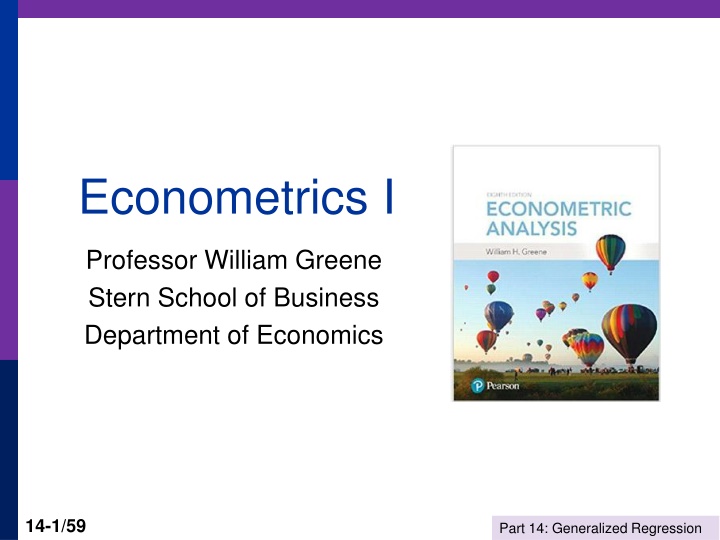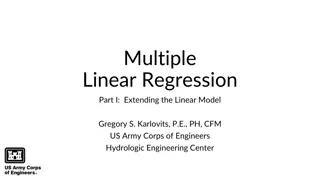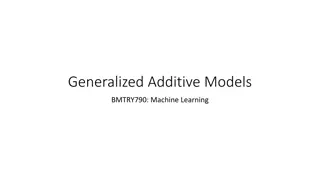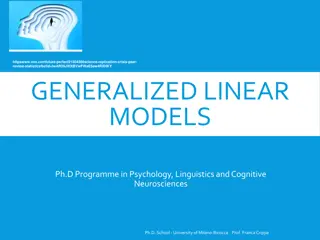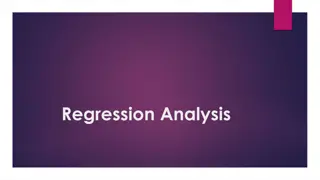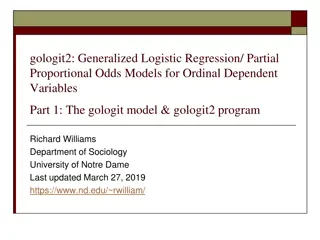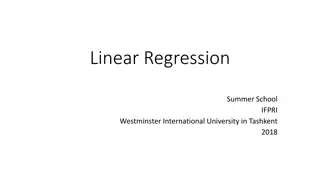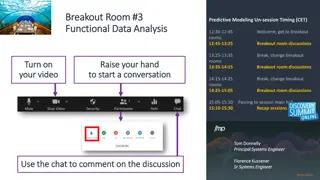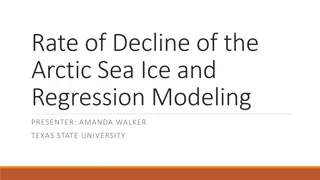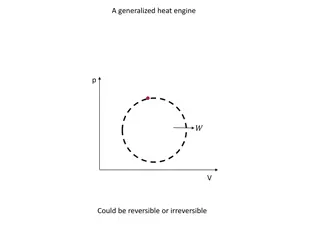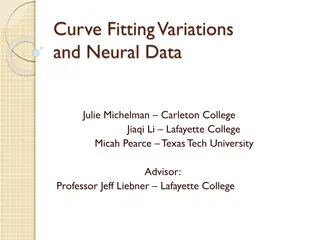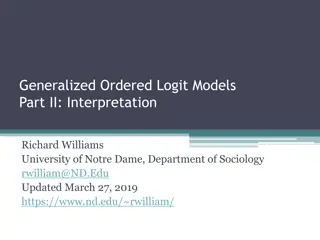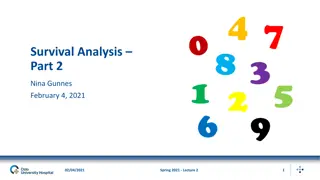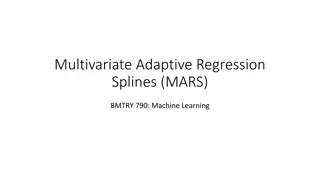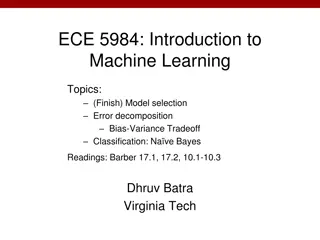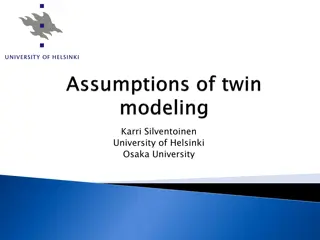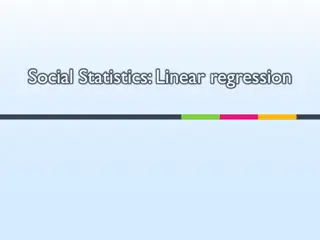Generalized Regression: Assumptions and Implications
The generalized regression model allows for varying variances and correlations among observations. Exploring the implications of these assumptions, such as the impact on least squares estimation and unbiasedness, is crucial for accurate statistical analysis.
Download Presentation

Please find below an Image/Link to download the presentation.
The content on the website is provided AS IS for your information and personal use only. It may not be sold, licensed, or shared on other websites without obtaining consent from the author.If you encounter any issues during the download, it is possible that the publisher has removed the file from their server.
You are allowed to download the files provided on this website for personal or commercial use, subject to the condition that they are used lawfully. All files are the property of their respective owners.
The content on the website is provided AS IS for your information and personal use only. It may not be sold, licensed, or shared on other websites without obtaining consent from the author.
E N D
Presentation Transcript
Econometrics I Professor William Greene Stern School of Business Department of Economics 14-1/59 Part 14: Generalized Regression
Krinsky and Robb standard error for a nonlinear function = = exp (1/ 2) / d u (1/ 2) d u u 2 = [ ] . . ( ) (1/ 2) . . Est AsyVar Est AsyVar u u Asymptotic Standard Error = (1/ 2) .5(1.166862).1008833 = .1008833 u = .0588584 14-2/59 Part 14: Generalized Regression
Econometrics I Part 14 Generalized Regression 14-3/59 Part 14: Generalized Regression
Generalized Regression Model Setting: The classical linear model assumes that E[ ] = Var[ ] = 2I. That is, observations are uncorrelated and all are drawn from a distribution with the same variance. The generalized regression (GR) model allows the variances to differ across observations and allows correlation across observations. 14-4/59 Part 14: Generalized Regression
Generalized Regression Model The generalized regression model: y = X + , E[ |X] = 0, Var[ |X] = 2 . Regressors are well behaved. Trace = n. This is a normalization. Mimics tr( 2 I) = n 2. Needed since Leading Cases Simple heteroscedasticity Autocorrelation Panel data and heterogeneity more generally. SUR Models for Production and Cost VAR models in Macroeconomics and Finance 1 c ( ) = 2 2 c for any c. 14-5/59 Part 14: Generalized Regression
Implications of GR Assumptions The assumption that Var[ ] = 2I is used to derive the result Var[b] = 2(X X)-1. If it is not true, then the use of s2(X X)-1 to estimate Var[b] is inappropriate. The assumption was also used to derive the t and F test statistics, so they must be revised as well. Least squares gives each observation a weight of 1/n. But, if the variances are not equal, then some observations are more informative than others. Least squares is based on simple sums, so the information that one observation might provide about another is never used. 14-6/59 Part 14: Generalized Regression
Implications for Least Squares Still unbiased. (Proof did not rely on ) For consistency, we need the true variance of b, Var[b|X] = E[(b- )(b- ) |X] =(X X)-1 E[X X] (X X)-1 = 2 (X X)-1X (Sandwich form of the covariance matrix.) X (X X)-1 . Divide all 4 terms by n. If the middle one converges to a finite matrix of constants, we have mean square consistency, so we need to examine (1/n)X X = (1/n) i j ijxixj . This will be another assumption of the model. Asymptotic normality? Easy for heteroscedasticity case, very difficult for autocorrelation case. 14-7/59 Part 14: Generalized Regression
Robust Covariance Matrix Robust estimation: Generality How to estimate Var[b|X] = (X X)-1X ( 2 )X(X X)-1 for the LS b? The distinction between estimating 2 an n n matrix and estimating the K K matrix 2 X X = 2 i j ijxixj NOTE VVVIRs for modern applied econometrics. The White estimator Newey-West estimator. 14-8/59 Part 14: Generalized Regression
The White Estimator n 1 2 i 1 = Est.Var[ ] b ( X'X ) e x x' ( X'X ) i i = i 1 (Heteroscedasticity robust covariance matrix.) Meaning of robust in this context Robust standard errors; (bis not robust ) Robust to: Heteroscedasticty Not robust to: (all considered later) Correlation across observations Individual unobserved heterogeneity Incorrect model specification Robust inference means hypothesis tests and confidence intervals using robust covariance matrices 14-9/59 Part 14: Generalized Regression
Inference Based on OLS What about s2(X X)-1 ? Depends on X are nearly the same, the OLS covariance matrix is OK. When will they be nearly the same? Relates to an interesting property of weighted averages. Suppose i is randomly drawn from a distribution with E[ i] = 1. X - X X. If they Then, (1/n) ixi2 E[x2] and (1/n) i ixi2 E[x2]. This is the crux of the discussion in your text. 14-10/59 Part 14: Generalized Regression
Inference Based on OLS VIR: For the heteroscedasticity to be substantive wrt estimation and inference by LS, the weights must be correlated with x and/or x2. (Text, page 305.) If the heteroscedasticity is substantive. Then, b is inefficient. The White estimator. ROBUST estimation of the variance of b. Implication for testing hypotheses. We will use Wald tests. (ROBUST TEST STATISTICS) 14-11/59 Part 14: Generalized Regression
Finding Heteroscedasticity The central issue is whether E[ 2] = 2 i is related to the xs or their squares in the model. Suggests an obvious strategy. Use residuals to estimate disturbances and look for relationships between ei2 and xi and/or xi2. For example, regressions of squared residuals on xs and their squares. 14-12/59 Part 14: Generalized Regression
Procedures White s general test: nR2 in the regression of ei2 on all unique xs, squares, and cross products. Chi-squared[P] Breusch and Pagan s Lagrange multiplier test. Regress {[ei2 /(e e/n)] 1} on Z (may be X). Chi-squared. Is nR2 with degrees of freedom rank of Z. 14-13/59 Part 14: Generalized Regression
A Heteroscedasticity Robust Covariance Matrix Uncorrected Note the conflict: Test favors heteroscedasticity. Robust VC matrix is essentially the same. 14-14/59 Part 14: Generalized Regression
Groupwise Heteroscedasticity Gasoline Demand Model Countries are ordered by the standard deviation of their 19 residuals. Regression of log of per capita gasoline use on log of per capita income, gasoline price and number of cars per capita for 18 OECD countries for 19 years. The standard deviation varies by country. The efficient estimator is weighted least squares. 14-15/59 Part 14: Generalized Regression
Analysis of Variance 14-16/59 Part 14: Generalized Regression
White Estimator (Not really appropriate for groupwise heteroscedasticity) +--------+--------------+----------------+--------+--------+----------+ |Variable| Coefficient | Standard Error |t-ratio |P[|T|>t]| Mean of X| +--------+--------------+----------------+--------+--------+----------+ Constant| 2.39132562 .11693429 20.450 .0000 LINCOMEP| .88996166 .03580581 24.855 .0000 -6.13942544 LRPMG | -.89179791 .03031474 -29.418 .0000 -.52310321 LCARPCAP| -.76337275 .01860830 -41.023 .0000 -9.04180473 ------------------------------------------------- White heteroscedasticity robust covariance matrix ------------------------------------------------- Constant| 2.39132562 .11794828 20.274 .0000 LINCOMEP| .88996166 .04429158 20.093 .0000 -6.13942544 LRPMG | -.89179791 .03890922 -22.920 .0000 -.52310321 LCARPCAP| -.76337275 .02152888 -35.458 .0000 -9.04180473 14-17/59 Part 14: Generalized Regression
Autocorrelated Residuals logG= 1 + 2logPg + 3logY + 4logPnc + 5logPuc + 14-18/59 Part 14: Generalized Regression
Newey-West Estimator Heteroscedasticity Component - Diagonal Elements 1 e n Autocorrelation Component - Off Diagonal Elements 1 we e ( n l w 1 = "Bartle L 1 n n n 2 i = S x x' 0 i i = i 1 L n t l t = + S x x x x ) 1 l t t l t t l = l 1 = + t l 1 = tt weight" l + X'X 1 1 1 X'X + Est.Var[ ]= b [ S S ] 0 1 n 14-19/59 Part 14: Generalized Regression
Newey-West Estimate --------+------------------------------------------------------------- Variable| Coefficient Standard Error t-ratio P[|T|>t] Mean of X --------+------------------------------------------------------------- Constant| -21.2111*** .75322 -28.160 .0000 LP| -.02121 .04377 -.485 .6303 3.72930 LY| 1.09587*** .07771 14.102 .0000 9.67215 LPNC| -.37361** .15707 -2.379 .0215 4.38037 LPUC| .02003 .10330 .194 .8471 4.10545 --------+------------------------------------------------------------- --------+------------------------------------------------------------- Variable| Coefficient Standard Error t-ratio P[|T|>t] Mean of X Robust VC Newey-West, Periods = 10 --------+------------------------------------------------------------- Constant| -21.2111*** 1.33095 -15.937 .0000 LP| -.02121 .06119 -.347 .7305 3.72930 LY| 1.09587*** .14234 7.699 .0000 9.67215 LPNC| -.37361** .16615 -2.249 .0293 4.38037 LPUC| .02003 .14176 .141 .8882 4.10545 --------+------------------------------------------------------------- 14-20/59 Part 14: Generalized Regression
Generalized Least Squares Approach Aitken theorem. The Generalized Least Squares estimator, GLS. Find P such that Py = PX + P y* = X* + *. E[ * * |X*]= 2I Use ordinary least squares in the transformed model. Satisfies the Gauss Markov theorem. b* = (X* X*)-1X* y* 14-21/59 Part 14: Generalized Regression
Generalized Least Squares Finding P A transformation of the model: P = -1/2. P P = -1 Py = PX + P or y* = X* + *. We need a noninteger power of a matrix: -1/2. 14-22/59 Part 14: Generalized Regression
(Digression) Powers of a Matrix (See slides 7:41-42) Characteristic Roots and Vectors = C C C = Orthogonal matrix of characteristic vectors. = Diagonal matrix of characteristic roots For positive definite matrix, elements of are all positive. General result for a power of a matrix: a = C aC . Characteristic roots are powers of elements of . C is the same. Important cases: Inverse: -1= C -1C Square root: 1/2 = C 1/2C Inverse of square root: -1/2= C -1/2C Matrix to zero power: 0 = C 0C = CIC = I 14-23/59 Part 14: Generalized Regression
Generalized Least Squares Finding P (Using powers of the matrix) E[ * * |X*] = PE[ | X*]P = PE[ |X]P = 2P P = 2 -1/2 -1/2 = 2 0 = 2I 14-24/59 Part 14: Generalized Regression
Generalized Least Squares Efficient estimation of and, by implication, the inefficiency of least squares b. = (X* X*)-1X* y* = (X P PX)-1 X P Py = (X -1X)-1X -1y b. is efficient, so by construction, b is not. 14-25/59 Part 14: Generalized Regression
Asymptotics for GLS Asymptotic distribution of GLS. (NOTE. We apply the full set of results of the classical model to the transformed model.) Unbiasedness Consistency - well behaved data Asymptotic distribution Test statistics 14-26/59 Part 14: Generalized Regression
Unbiasedness - 1 1 -1 = = ( X' X ) X' y - 1 1 -1 + ( X' X ) X' -1 1 -1 + E[ | ]= X ( X' X ) X' E[ | X ] = = if E[ | X ] 0 14-27/59 Part 14: Generalized Regression
Consistency Use Mean Square 1 2 -1 n X' X X Var[ | ]= 0 ? n -1 X' X Requires to be "well behaved" n Either converge to a constant matrix or diverge. Heteroscedasticity case: Easy to establish 1 ( ) n n Autocorrelation case: Complicated. Need assumptions 1 ( ) n n -1 X' X 1 n 1 n n -1 = = x x ' x x' ii i i i i ii = i 1 = i 1 -1 X' X n n -1 2 = . n terms. x x ' ij i j = i 1 = j 1 14-28/59 Part 14: Generalized Regression
Asymptotic Normality 1 1 X X ' 1 n 1 = n( ) n X ' n Converge to normal with a stable variance O(1)? 1 1 n Heterosceda 1 X X ' a constant matrix? Assumed. n 1 X ' a mean to which we can apply the central limit theorem? sticity case? = x x 1 n 1 n n 1 2 X = ' . Var , is just data. i i i i = i 1 i i i i Apply Lindeberg-Feller. Autocorrelation case? More complicated. 14-29/59 Part 14: Generalized Regression
Asymptotic Normality (Cont.) For the autocorrelation case 1 n 1 n n n 1 ij X = ' x i j = i 1 = j 1 Does the double sum converge? Uncertain. Requires elements of to become small as the distance between i and j increases. (Has to resemble the heteroscedasticity case.) 1 14-30/59 Part 14: Generalized Regression
Test Statistics (Assuming Known ) With known , apply all familiar results to the transformed model: With normality, t and F statistics apply to least squares based on Py and PX With asymptotic normality, use Wald statistics and the chi-squared distribution, still based on the transformed model. 14-31/59 Part 14: Generalized Regression
Unknown would be known in narrow heteroscedasticity cases. is usually unknown. For now, we will consider two methods of estimation Two step, or feasible estimation. Estimate first, then do GLS. Emphasize - same logic as White and Newey-West. We don t need to estimate . We need to find a matrix that behaves the same as (1/n)X -1X. Full information estimation of , 2, and all at the same time. Joint estimation of all parameters. Fairly rare. Some generalities. We will examine Harvey s model of heteroscedasticity 14-32/59 Part 14: Generalized Regression
Specification must be specified first. A full unrestricted contains n(n+1)/2 - 1 parameters. (Why minus 1? Remember, tr( ) = n, so one element is determined.) is generally specified in terms of a few parameters. Thus, = ( ) for some small parameter vector . It becomes a question of estimating . 14-33/59 Part 14: Generalized Regression
Two Step Estimation The general result for estimation when is estimated. GLS uses [X -1X]X -1 y which converges in probability to . We seek a vector which converges to the same thing that this does. Call it Feasible GLS or FGLS, based on [X X]X y The object is to find a set of parameters such that [X X]X y - [X -1X]X -1 -1 -1y 0 -1 -1 14-34/59 Part 14: Generalized Regression
Two Step Estimation of the Generalized Regression Model Use the Aitken (Generalized Least Squares - GLS) estimator with an estimate of 1. is parameterized by a few estimable parameters. Examples, the heteroscedastic model 2. Use least squares residuals to estimate the variance functions 3. Use the estimated in GLS - Feasible GLS, or FGLS [4. Iterate? Generally no additional benefit.] 14-35/59 Part 14: Generalized Regression
FGLS vs. Full GLS VVIR (Theorem 9.5) To achieve full efficiency, we do not need an efficient estimate of the parameters in , only a consistent one. 14-36/59 Part 14: Generalized Regression
Heteroscedasticity Setting: The regression disturbances have unequal variances, but are still not correlated with each other: Classical regression with hetero-(different) scedastic (variance) disturbances. yi = xi + i, E[ i] = 0, Var[ i] = 2 i, i > 0. A normalization: i i = n. The classical model arises if i = 1. A characterization of the heteroscedasticity: Well defined estimators and methods for testing hypotheses will be obtainable if the heteroscedasticity is well behaved in the sense that no single observation becomes dominant. 14-37/59 Part 14: Generalized Regression
Generalized (Weighted) Least Squares Heteroscedasticity Case 0 0 0 0 ... ... ... ... 0 0 0 1 0 0 2 2 2 = = Var[ X ] n 1 / 0 ... 0 1 0 0 1 / ... ... 0 0 -1/2 = 2 0 0 0 ... 1 / n 1 1 1 n n i -1 1 -1 = = ( X' X ) ( X' y ) x x x y i i i = i 1 = i 1 i i 2 i K y x n i = i 1 i 2 = n 14-38/59 Part 14: Generalized Regression
Estimation: WLS form of GLS General result - mechanics of weighted least squares. Generalized least squares - efficient estimation.Assuming weights are known. Two step generalized least squares: Step 1: Use least squares, then the residuals to estimate the weights. Step 2: Weighted least squares using the estimated weights. (Iteration: After step 2, recompute residuals and return to step 1. Exit when coefficient vector stops changing.) 14-39/59 Part 14: Generalized Regression
FGLS Harveys Model Feasible GLS is based on finding an estimator which has the same properties as the true GLS. Example Var[ i|zi] = 2 [Exp( zi)]2. True GLS would regress yi/[ Exp( zi)] on the same transformation of xi. With a consistent estimator of [ , ], say [s,c], we do the same computation with our estimates. So long as plim [s,c] = [ , ], FGLS is as good as true GLS. Consistent Same Asymptotic Variance Same Asymptotic Normal Distribution 14-40/59 Part 14: Generalized Regression
Harveys Model of Heteroscedasticity Var[ i | X] = 2 exp( zi) Cov[ i, j | X] = 0 e.g.: zi = firm size e.g.: zi = a set of dummy variables (e.g., countries) (The groupwise heteroscedasticity model.) [ 2 ] = diagonal [exp( + zi)], = log( 2) 14-41/59 Part 14: Generalized Regression
Harveys Model Methods of estimation: Two step FGLS: Use the least squares residuals to estimate ( , ), then use ( 1 ) ( ) = = 1 1 X X X y Full maximum likelihood estimation. Estimate all parameters simultaneously. A handy result due to Oberhofer and Kmenta - the zig-zag approach. Iterate back and forth between ( , )and . 14-42/59 Part 14: Generalized Regression
Harveys Model for Groupwise Heteroscedasticity Groupwise sample, yig, xig, N groups, each with ng observations. Var[ ig] = g2 Let dig = 1 if observation i,g is in group g, 0 else. = group dummy variable. (Drop the first.) Var[ ig] = g2 exp( 2d2+ GdG) Var1 = g2 , Var2 = g2 exp( 2) and so on. 14-43/59 Part 14: Generalized Regression
Estimating Variance Components OLS is still consistent: Est.Var1 = e1 e1/n1 estimates g2 Est.Var2 = e2 e2/n2 estimates g2 exp( 2), etc. Estimator of 2 is ln[(e2 e2/n2)/(e1 e1/n1)] (1) Now use FGLS weighted least squares Recompute residuals using WLS slopes (2) Recompute variance estimators Iterate to a solution between (1) and (2) 14-44/59 Part 14: Generalized Regression
Baltagi and Griffins Gasoline Data World Gasoline Demand Data, 18 OECD Countries, 19 years Variables in the file are COUNTRY = name of country YEAR = year, 1960-1978 LGASPCAR = log of consumption per car LINCOMEP = log of per capita income LRPMG = log of real price of gasoline LCARPCAP = log of per capita number of cars See Baltagi (2001, p. 24) for analysis of these data. The article on which the analysis is based is Baltagi, B. and Griffin, J., "Gasoline Demand in the OECD: An Application of Pooling and Testing Procedures," European Economic Review, 22, 1983, pp. 117-137. The data were downloaded from the website for Baltagi's text. 14-45/59 Part 14: Generalized Regression
Least Squares First Step ---------------------------------------------------------------------- Multiplicative Heteroskedastic Regression Model... Ordinary least squares regression ............ LHS=LGASPCAR Mean = 4.29624 Standard deviation = .54891 Number of observs. = 342 Model size Parameters = 4 Degrees of freedom = 338 Residuals Sum of squares = 14.90436 B/P LM statistic [17 d.f.] = 111.55 (.0000) (Large) Cov matrix for b is sigma^2*inv(X'X)(X'WX)inv(X'X) (Robust) --------+------------------------------------------------------------- Variable| Coefficient Standard Error b/St.Er. P[|Z|>z] Mean of X --------+------------------------------------------------------------- Constant| 2.39133*** .20010 11.951 .0000 LINCOMEP| .88996*** .07358 12.094 .0000 -6.13943 LRPMG| -.89180*** .06119 -14.574 .0000 -.52310 LCARPCAP| -.76337*** .03030 -25.190 .0000 -9.04180 --------+------------------------------------------------------------- 14-46/59 Part 14: Generalized Regression
Variance Estimates = ln[e(i)e(i)/T] Sigma| .48196*** .12281 3.924 .0001 D1| -2.60677*** .72073 -3.617 .0003 .05556 D2| -1.52919** .72073 -2.122 .0339 .05556 D3| .47152 .72073 .654 .5130 .05556 D4| -3.15102*** .72073 -4.372 .0000 .05556 D5| -3.26236*** .72073 -4.526 .0000 .05556 D6| -.09099 .72073 -.126 .8995 .05556 D7| -1.88962*** .72073 -2.622 .0087 .05556 D8| .60559 .72073 .840 .4008 .05556 D9| -1.56624** .72073 -2.173 .0298 .05556 D10| -1.53284** .72073 -2.127 .0334 .05556 D11| -2.62835*** .72073 -3.647 .0003 .05556 D12| -2.23638*** .72073 -3.103 .0019 .05556 D13| -.77641 .72073 -1.077 .2814 .05556 D14| -1.27341* .72073 -1.767 .0773 .05556 D15| -.57948 .72073 -.804 .4214 .05556 D16| -1.81723** .72073 -2.521 .0117 .05556 D17| -2.93529*** .72073 -4.073 .0000 .05556 14-47/59 Part 14: Generalized Regression
OLS vs. Iterative FGLS Looks like a substantial gain in reduced standard errors --------+------------------------------------------------------------- Variable| Coefficient Standard Error b/St.Er. P[|Z|>z] Mean of X --------+------------------------------------------------------------- |Ordinary Least Squares |Robust Cov matrix for b is sigma^2*inv(X'X)(X'WX)inv(X'X) Constant| 2.39133*** .20010 11.951 .0000 LINCOMEP| .88996*** .07358 12.094 .0000 -6.13943 LRPMG| -.89180*** .06119 -14.574 .0000 -.52310 LCARPCAP| -.76337*** .03030 -25.190 .0000 -9.04180 --------+------------------------------------------------------------- |Regression (mean) function Constant| 1.56909*** .06744 23.267 .0000 LINCOMEP| .60853*** .02097 29.019 .0000 -6.13943 LRPMG| -.61698*** .01902 -32.441 .0000 -.52310 LCARPCAP| -.66938*** .01116 -59.994 .0000 -9.04180 14-48/59 Part 14: Generalized Regression
Methodology In the possible presence of heteroscedasticity: = = + + + (Cornwell&Rupert: lwage = f(exp,wks,smsa,...) (z , ) Step 1: Within (dummy variable estimator, a , ) Step 2: a ( ) 1 ( | ) ( i i i Var a z x T y x z it i it it + = w ed fem 0 i i i i b i = + = + + + a z w v 0 i i i i i i i = + + 2 w 2 1 ' ) X X x i OLS with the White estimator Weighted Least Squares 14-49/59 Part 14: Generalized Regression
Seemingly Unrelated Regressions The classical regression model, yi = Xi i + i. Applies to each of M equations and T observations. Familiar example: The capital asset pricing model: (rm - rf) = mi + m( rmarket rf ) + m Not quite the same as a panel data model. M is usually small - say 3 or 4. (The CAPM might have M in the thousands, but it is a special case for other reasons.) 14-50/59 Part 14: Generalized Regression
